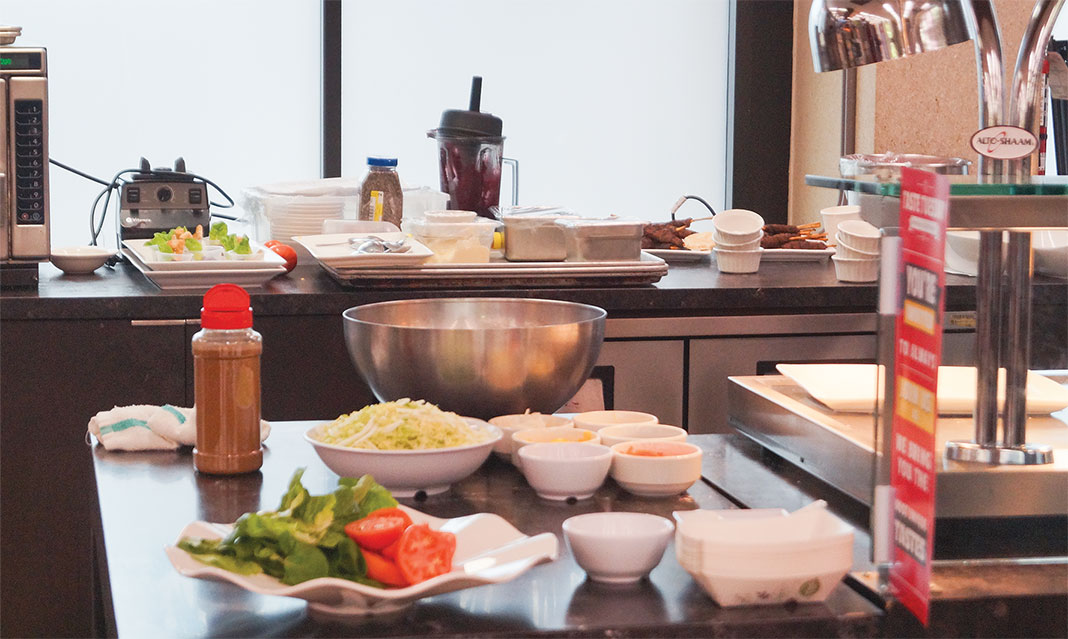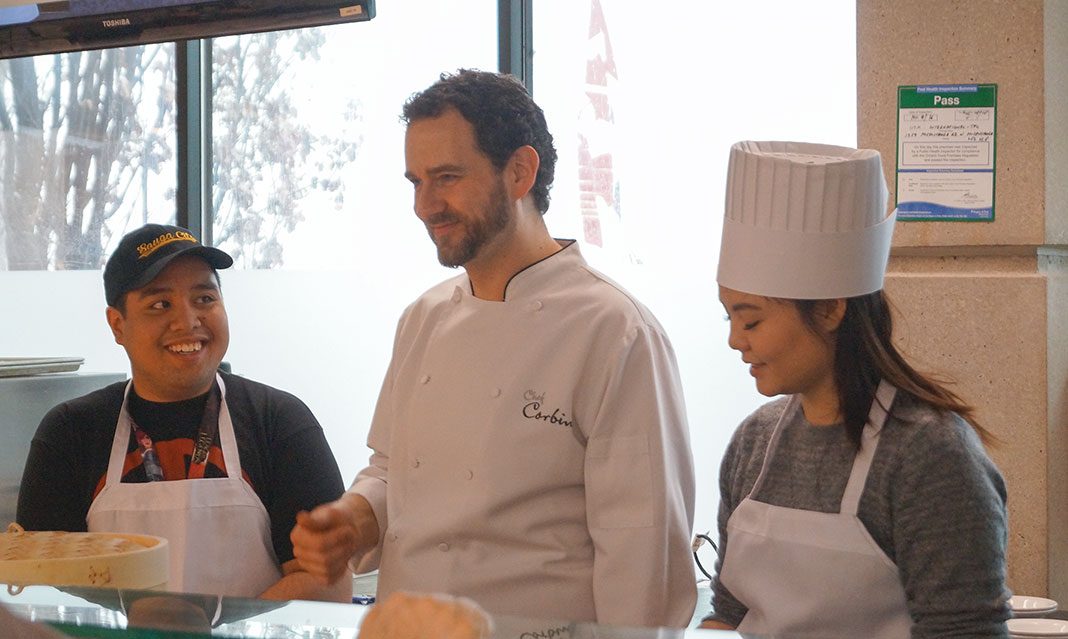When you think of food truck cuisine, what comes to mind? Maybe your thoughts drift to images of mouth-watering hotdogs loaded with your favourite toppings, or visions of classic medium-aged cheddar cheese sandwiched between two perfectly grilled slices of bread. Poutine, tacos, perogies, lobster rolls— the list of food truck dishes is endless.
Last Tuesday, celebrity chef Corbin Tomaszeski launched two new dishes by putting an international flair on a popular food truck meal: sliders. Known from TV shows such as Dinner Party Wars on Food Network, Tomaszeski provided a live demonstration in the TFC that attracted a large lunchtime crowd.
“Today, we are launching a new program. We are doing some samplings on something called ‘Slider Palooza.’ Do you know what Palooza means? Palooza’s like a big party. Do you know what a slider is? Like mini sandwiches, they just slide right in,” he explains. “So today we’re going to do two variations. Because of all the diversity that exists in this university campus, I thought we would take advantage of that and pull influences from all around the world.”
Tomaszeski prepared two dishes for his audience during his live demonstration. “We’re doing an Asian-inspired Bao bun stuffed with spiced sesame chicken and five spice slaw, and then we’re also doing a sesame pita with lamb kofta, so we got a little Middle Eastern in there.”
Specifically, the first dish was Moroccan Lamb Kofta with Sesame Pita and Beet Hummus, while the second dish was Steamed Bao Bun with Crispy Sesame Chicken and five spice slaw.
“For me, it’s how it’s presented. For example, anyone can make hummus, so we made a beet hummus which was fun, super healthy, high in anti-oxidants, and one of those superfoods. That’s going to be one of the [food truck] twists, and then when we do the slaw we’re going to do some fun stuff with that, add a little bit of heat too,” he said.
Tomaszeski began the first demonstration by spontaneously selecting three students to join him for the cooking process. He gave each student an apron and a chef hat to wear in the kitchen. All three participants were responsible for a different aspect of the culinary process. Whether it was mixing meat, adding spices, or making hummus, Tomaszeski gave his three volunteers a hands-on opportunity to create the lamb kofta and hummus dish.
Together, they prepared the meat mix with one pound of ground lamb and beef each. While one student mixed, the other added seasonings like coriander, cumin, black pepper, and smoked paprika.
Tomaszeski advised his volunteers and his audience that it is important to cook, taste, and adjust seasonings accordingly to ensure the best possible result. He made a tiny patty out of the meat, grilled it, and had his volunteers taste it. Then, he added some extra spices to the meat mix to enhance flavour and spiciness.
Hummus, typically made from chickpeas, was instead made with red beets. They added red beets, vegetable oil, and tahini into a blender. Once the meat mix was ready, they shaped the meat into a sausage on a chopstick, and placed it on the grill.
The team formed an assembly line to construct the final dish and distribute it to their audience to taste. They served the lamb kofta skewer on the sesame pita. The meat rested on a bed of lettuce, and was topped with onions, crimson beet hummus, and a dollop of sour cream.
It wasn’t long before the crowd dug into their samples. Anxious to taste the meal my peers had prepared with the celebrity chef, I dove into my own kofta. The spiciness of the meat complemented the flavour of the beet hummus. I was hooked.
For the second demo, the procedure was much the same. Tomaszeski selected a new trio of students willing to lend him a hand behind the counter.
Tomaszeski explained that for the dish, they would be using boneless, skinless chicken legs because of its high flavour content. Also, chicken breasts are more likely to dry out during the frying process.
The TFC began to embody the atmosphere of a professional kitchen: fast, hot, and loud. The team effortlessly prepared the chicken, adding ingredients like minced ginger, garlic, and chili paste. Then, they breaded the chicken in a mix of bread crumbs and white and black sesame seeds.

Forming an assembly line, the three volunteers constructed the second dish. They laid the five spice slaw onto the Bao, a Vietnamese steam bun, and rested the breaded chicken legs on top. Chef Tomaszeski concluded the plating by drizzling honey over the chicken and handing it to the hungry audience members.
After the first dish, I didn’t hesitate to try this one. The crispy chicken had a hint of sweetness from the honey, the slaw was creamy, and I was satisfied.
Tomaszeski explains that adding a twist to this common food truck concept wasn’t challenging.
“It’s kind of like when you see a kid in a sandbox and they’re having a lot of fun. That’s how I am when I do recipe development, just a lot cleaner,” he says.
So, what is Tomaszeski’s favourite food truck dish?
“That’s a tough one,” he hesitates. “I’m still a sucker for poutine, I think it’s the Canadian boy in me. I think if you’ve got a solid poutine, I’m all over it. But it has to be real curds, real Quebec curds, none of those fake curds, and I want real gravy and nice, crispy fries.”



